Science & Technology

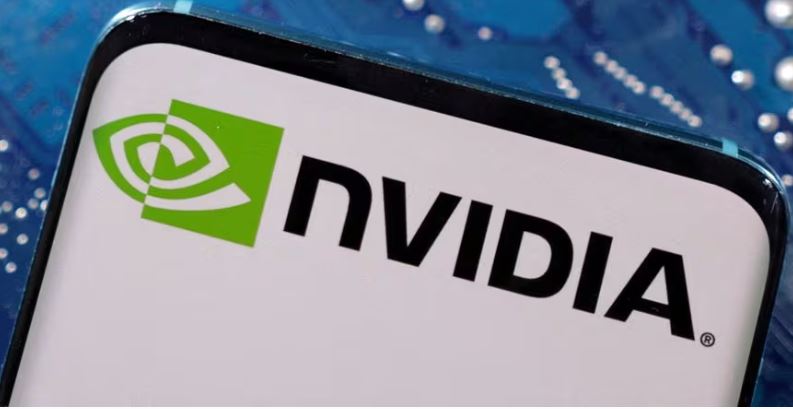
BEIJING/SINGAPORE, Jan 8 (Reuters) - U.S. chipmaker Nvidia (NVDA.O) plans to begin mass production in the second quarter of 2024 of an artificial intelligence (AI) chip it designed for China to comply with U.S.
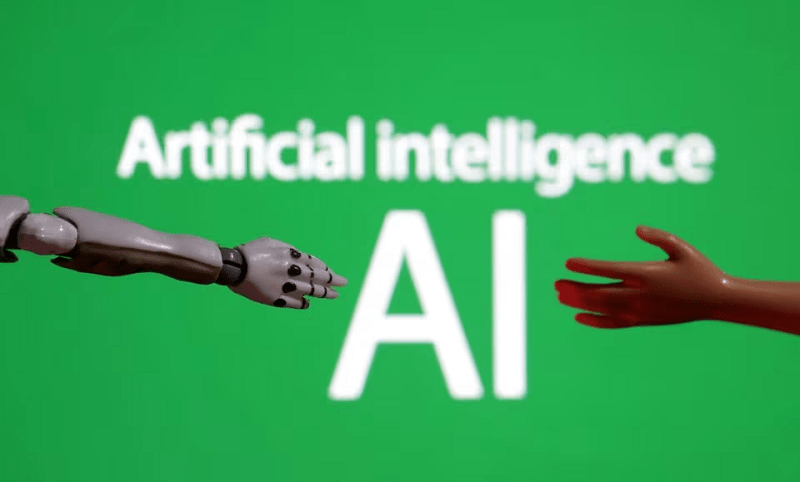
LONDON: A US computer scientist lost his bid on Wednesday to register patents over inventions created by his artificial intelligence system in a landmark case in Britain about whether AI can own patent rights.
Stephen Thaler wanted to be granted two patents in the UK for inventions he says were devised by his “creativity machine” called DABUS. His attempt to register the patents was refused by the UK’s Intellectual Property Office (IPO) on the grounds that the inventor must be a human or a company, rather than a machine.
Thaler approached the UK’s Supreme Court, which rejected his appeal as under UK patent law “an inventor must be a natural person”.
Judge David Kitchin said in the court’s written ruling that the case was “not concerned with the broader question whether technical advances generated by machines acting autonomously and powered by AI should be patentable”.
Thaler’s lawyers said the ruling “establishes that UK patent law is currently wholly unsuitable for protecting inventions generated autonomously by AI machines and as a consequence wholly inadequate in supporting any industry that relies on AI in the development of new technologies”.
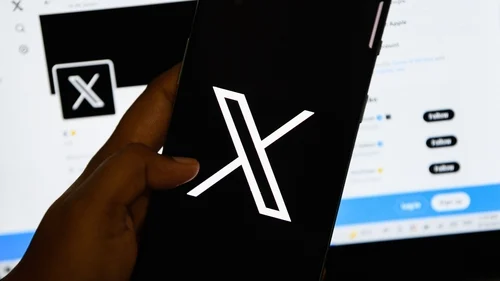
Social media platform X, formerly known as Twitter, was restored globally early on Thursday after outages were reported by users facing issues at the peak of the outage.
Users on X, formerly known as Twitter, were unable to view posts on the social media site with a message that said “Welcome to X!”. Reports of the platform’s troubles began spiking just before 0500 GMT on monitoring site Downdetector.
Users encountered loading issues on X Pro, formerly TweetDeck, with a message that said “Waiting for posts”.
Over 77,000 US users faced access issues with X and X Pro, according to Downdetector data. With no way to post on X, social media users published updates about the outage on rivals including Facebook, Threads, and Reddit, as well as Meta’s rival app, Threads.
Downdetector tracks outages by collating status reports from several sources including users.
In Pakistan, nearly 1,000 reports of outages were reported at 10:30am. Access to X was later restored for users in Pakistan a little after 12pm.
There has been no immediate comment from X, nor any indication of what caused the outage.
X is currently facing multiple headwinds, including an EU probe under a law designed to combat disinformation and hate, criticism of the platform’s response to recent rioting in Dublin, and an exodus of big-name advertisers.
Elon Musk’s company is now worth less than half of the $44 billion he paid for it in October 2022, according to internal documents sent to staff and reported by tech publication The Verge.
The $44 billion acquisition lead to several layoffs, including those of numerous engineers responsible for fixing and preventing service outages, sources have previously told Reuters.
A major outage on X was also reported by Downdetector in February, affecting thousands of users. User complaints shared online included being unable to post messages, being told they had exceeded a daily limit of posts, and the inability to send direct messages.

WASHINGTON: More than 50 years after the last Apollo mission, the United States will try once again to land a craft on the Moon on January 25, said the head of what could be the first private company to successfully touch down on the lunar surface.
The lander, named Peregrine, will have no one on board.
It was developed by American company Astrobotic, whose CEO John Thornton said it will carry NASA instruments to study the lunar environment in anticipation of NASA’s Artemis manned missions.
Several years ago, NASA opted to commission US companies to send scientific experiments and technologies to the Moon — a programme called CLPS.
These fixed-price contracts should make it possible to develop a lunar economy, and provide transport services at a lower cost.
“One of the big challenges of what we’re attempting here is attempting a launch and landing on the surface Moon for a fraction of what it would otherwise cost,” said Thornton on Wednesday at a press briefing at his company’s base in Pittsburgh.
“Only about half of the missions that have gone to the surface of the Moon have been successful,” he said. “So it’s certainly a daunting challenge. I’m going to be terrified and thrilled all at once at every stage of this.”
Takeoff is scheduled for December 24 from Florida aboard the inaugural flight of the new rocket from the ULA industrial group, named Vulcan Centaur.
The probe will then take “a few days” to reach lunar orbit, but will have to wait until January 25 before attempting landing, so that light conditions at the target location are right, Thornton said.
The descent will be carried out autonomously, without human intervention, but will be monitored from the company’s control center.
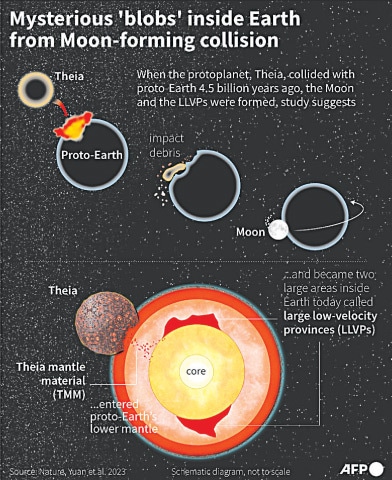
PARIS: Scientists proposed a novel idea on Wednesday that could solve two of the world’s mysteries at once — one that passes over our heads every night, and one that sits far below our feet.
The first mystery has puzzled everyone from scientists to inquisitive children for millennia: where did the Moon come from? The leading theory is that the Moon was created 4.5 billion years ago when a would-be planet the size of Mars smashed into the still-forming Earth.
This epic collision between early Earth and the proto-planet called Theia shot an enormous amount of debris into orbit, which formed what would become the Moon.
Or so the theory goes. Despite decades of effort, scientists have not been able to find any evidence of Theia’s existence. New US-led research, published in the journal Nature, suggests they might have been looking in the wrong direction.
Around 2,900 kilometres below Earth’s surface, two massive “blobs” have baffled geologists since seismic waves revealed their existence in the 1980s. These continent-sized clumps of material straddle the bottom of Earth’s rocky mantle near its molten core, one below Africa and the other underneath the Pacific Ocean.
Scientists have determined that the blobs are much hotter and more dense that the surrounding rock, but much else about them remains a mystery.
The new research indicates the blobs are “buried relics” of Theia that entered into Earth during their formative collision — and have been hiding near our planet’s heart ever since.
As well as creating the Moon, this collision and the remnants it left behind may have helped Earth become the unique life-hosting planet it is today, the researchers proposed.
Qian Yuan, a geodynamics researcher at the California Institute of Technology and the study’s lead author, said it is “very, very strange” that no evidence of the Theia impact has been found.
It was during a class held by a planetary scientist discussing this mystery that Yuan first connected the dots. “Where is the impactor? My answer is: it’s in the Earth,” he said. The planetary scientist holding the class had never heard of the blobs.
The research has since required experts in the often separate fields of space and geology to join forces. Yuan said that when Theia smashed into proto-Earth, it was travelling at more than 10 kilometres (six miles) a second, a speed that allowed some of it to penetrate “very deep into the Earth’s lower mantle”.
A video developed by the team simulating this process illustrates how clumps of Theia’s mantle tens of kilometres wide swirled inside Earth. As the mostly molten Theia material cooled and solidified, its high level of iron caused it to sink down to the border of Earth’s mantle and core, the scientists proposed.
Over the years it accumulated into two separate blobs — officially called large low-velocity provinces (LLVPs) — that are now each larger than the Moon, Yuan said.
Testing a theory based so far back in time — and so deep under Earth — is incredibly difficult, and Yuan emphasised that their modelling could not be “100 per cent” certain.
But if true, the implications could be immense. Earth remains the only planet in the universe known to be capable of supporting life.
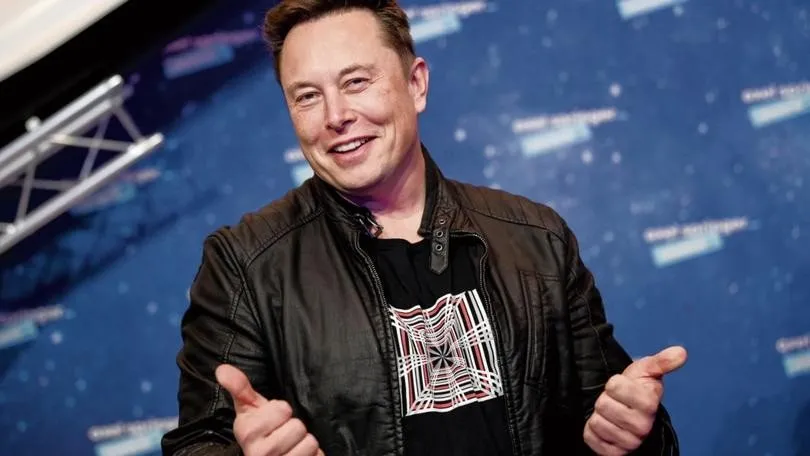
The “X” platform (formerly Twitter) launched two new subscriptions on Friday, exactly a year after Elon Musk bought the social network, which is currently suffering from financial difficulties, reports Al-Rai daily.
Users can now choose from three plans: the Basic plan, the standard plan (Premium, formerly known as the “Blue” service), and the premium plan (Premium +), at prices of $3, $8, and $16 per month, respectively.
In addition to the benefits included in the Premium plan, Premium+ subscribers will benefit from better viewing of their messages (giving them a greater chance of being read and generating interactions), and they will not see any cross-platform advertising.
The cheapest option includes basic editing tools (including the ability to correct a message or post longer videos), two-factor authentication, but no access to creator tools (which allow for revenue) and the famous blue verification checkmark.
The subscription to the “Blue” service was launched chaotically in the months following the Tesla CEO’s acquisition of Twitter for $44 billion, and its goal was to diversify sources of income and make account verification available to all interested users.
Whereas the blue verification mark was previously free and limited to specific categories of users with a certain level of fame, the feature has become paid but available to everyone.
Between this method and the sharp decline in content control, the use of the platform has become more confusing, with the increase of fake accounts whose owners buy the blue verification mark and exploit it to spread false information or rumors.
Many advertisers chose to withdraw from X. The platform’s value fell to $20 billion, and advertising revenues fell by half, according to Elon Musk. The network may become pay-for-all: in New Zealand and the Philippines, new users must pay $1 each year to use the app.
The network justified this move by seeking to curb automated accounts that could be used to artificially amplify political messages, for example.
The billionaire hopes to turn the platform into a multi-use application, similar to the Chinese WeChat model, which works as a messaging and online payment service.
Musk began testing adding a tool to make direct audio and video calls from “X”.
On Friday, he wrote the word “Freedom” on his personal page, republishing his message that he wrote a year ago, shortly after the takeover, “The bird is free,” in reference to Twitter’s blue bird, a slogan that is no longer used.

A manager at artificial intelligence firm OpenAI caused consternation recently by writing that she just had “a quite emotional, personal conversation” with her firm’s viral chatbot ChatGPT. “Never tried therapy before but this is probably it?” Lilian Weng posted on X, formerly Twitter, prompting a torrent of negative commentary accusing her of downplaying mental illness.
However, Weng’s take on her interaction with ChatGPT may be explained by a version of the placebo effect outlined this week by research in the Nature Machine Intelligence journal. A team from Massachusetts Institute of Technology (MIT) and Arizona State University asked more than 300 participants to interact with mental health AI programs and primed them on what to expect. Some were told the chatbot was empathetic, others that it was manipulative and a third group that it was neutral.
Those who were told they were talking with a caring chatbot were far more likely than the other groups to see their chatbot therapists as trustworthy. “From this study, we see that to some extent the AI is the AI of the beholder,” said report co-author Pat Pataranutaporn. Buzzy startups have been pushing AI apps offering therapy, companionship and other mental health support for years now—and it is big business. But the field remains a lightning rod for controversy.
‘Weird, empty’
Like every other sector that AI is threatening to disrupt, critics are concerned that bots will eventually replace human workers rather than complement them. And with mental health, the concern is that bots are unlikely to do a great job. “Therapy is for mental well-being and it’s hard work,” Cher Scarlett, an activist and programmer, wrote in response to Weng’s initial post on X. “Vibing to yourself is fine and all but it’s not the same.” Compounding the general fear over AI, some apps in the mental health space have a chequered recent history.
Users of Replika, a popular AI companion that is sometimes marketed as bringing mental health benefits, have long complained that the bot can be sex obsessed and abusive. Separately, a US nonprofit called Koko ran an experiment in February with 4,000 clients offering counseling using GPT-3, finding that automated responses simply did not work as therapy.
“Simulated empathy feels weird, empty,” the firm’s co-founder, Rob Morris, wrote on X. His findings were similar to the MIT/Arizona researchers, who said some participants likened the chatbot experience to “talking to a brick wall”. But Morris was later forced to defend himself after widespread criticism of his experiment, mostly because it was unclear if his clients were aware of their participation.
‘Lower expectations’
David Shaw from Basel University, who was not involved in the MIT/Arizona study, told AFP the findings were not surprising. But he pointed out: “It seems none of the participants were actually told all chatbots bullshit.” That, he said, may be the most accurate primer of all. Yet the chatbot-as-therapist idea is intertwined with the 1960s roots of the technology.
ELIZA, the first chatbot, was developed to simulate a type of psychotherapy. The MIT/Arizona researchers used ELIZA for half the participants and GPT-3 for the other half. Although the effect was much stronger with GPT-3, users primed for positivity still generally regarded ELIZA as trustworthy.
So it is hardly surprising that Weng would be glowing about her interactions with ChatGPT—she works for the company that makes it. The MIT/Arizona researchers said society needed to get a grip on the narratives around AI. “The way that AI is presented to society matters because it changes how AI is experienced,” the paper argued. “It may be desirable to prime a user to have lower or more negative expectations.”—AFP


